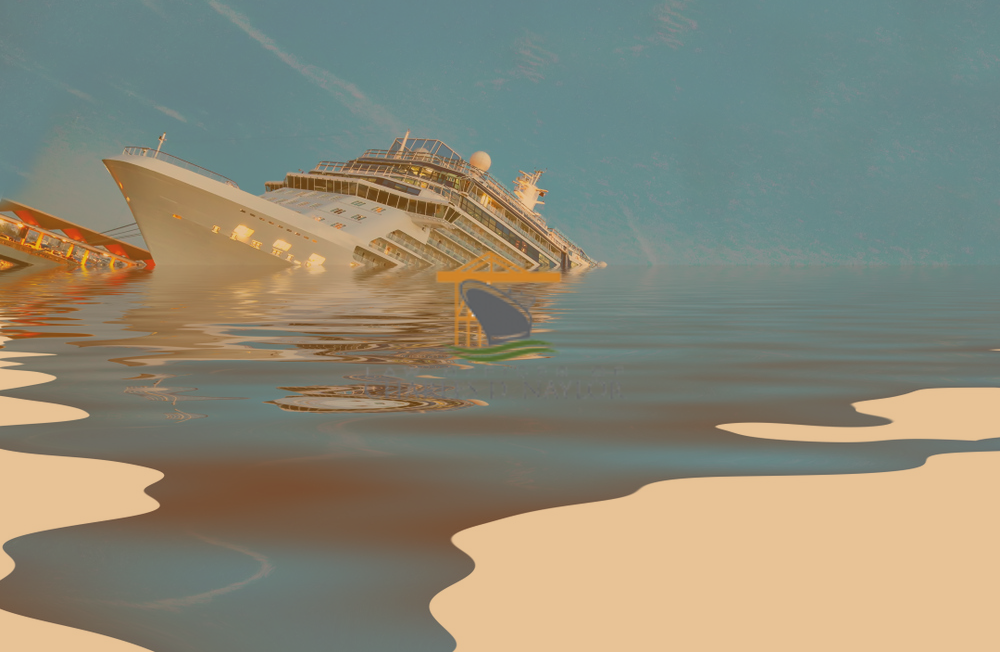Cruise ships promise unforgettable vacations filled with luxurious amenities and exciting destinations. However, cruise ship disasters remind us that these floating resorts are not immune to accidents and tragedies.
Understanding the risks from mechanical failures to environmental hazards can help travelers make informed decisions.

Notable Cruise Ship Disasters in History
Cruise ship disasters are rare but can have catastrophic consequences when they occur. Several incidents serve as sobering reminders of the potential dangers:
RMS Titanic (1912):
One of the most infamous maritime disasters, the Titanic, struck an iceberg, resulting in over 1,500 fatalities. This tragedy led to significant changes in marine safety regulations.
Costa Concordia (2012):
The ship ran aground off the Italian coast, leading to 32 deaths. Human error was a primary cause, highlighting the importance of trained personnel and emergency preparedness.
Norwegian Dawn (2005):
Mechanical failure caused the ship to list dramatically, injuring passengers and raising concerns about equipment maintenance.
A Timeline of Major Cruise Ship Disasters
| Year | Incident | Ship Name | Location | Casualties/Injuries | Cause/Notes |
| 1912 | Sinking of the Titanic | RMS Titanic | North Atlantic Ocean | 1,500+ deaths | Iceberg collision |
| 2012 | Costa Concordia Grounding | Costa Concordia | Giglio Island, Italy | 32 deaths, 64 injured | Human error and negligence |
| 2020 | COVID-19 Outbreak | Diamond Princess | Yokohama, Japan | 700+ infections | Poor health protocol enforcement |
| 2019 | Viking Sky Engine Failure | Viking Sky | Norwegian Sea | 0 deaths, 479 rescued | Engine failure in rough seas |
This timeline provides a glimpse into notable incidents and highlights how cruise ship disasters span decades, caused by human error, natural events, and technical issues.
Understanding Passenger Rights After a Cruise Ship Disaster
Cruise passengers have legal rights under U.S. maritime laws, including claims for personal injury, medical expenses, and compensation for distress. Key protections include:
- Jones Act Protections: Offers recourse for injured seafarers.
- Passenger Contracts: These detail limited liability but may still allow claims for negligence.
- Cruise Vessel Security and Safety Act of 2010: Mandates reporting of crimes and outlines passenger safety measures.
Passengers unsure of their rights can consult a maritime attorney to navigate these complex legal frameworks.
Lessons Learned From Major Disasters
Each disaster brings new regulations and protocols. For example:
- Titanic: Spurred the creation of the International Convention for the Safety of Life at Sea (SOLAS).
- Costa Concordia: Highlighted the importance of evacuation procedures.
- COVID-19 Pandemic: Accelerated the need for health protocols like pre-boarding testing and quarantine zones.
Current Safety Standards for Modern Cruise Ships
Modern cruise ships follow stringent safety measures:
- Advanced Navigation Systems: Automated alerts for obstacles.
- Lifeboat Standards: Sufficient capacity for all passengers.
- Health Protocols: Regular inspections and pandemic-specific protocols.
What Causes Cruise Ship Disasters?
Several factors contribute to cruise ship disasters:
Human Error
The International Maritime Organization reports that human error accounts for over 75% of maritime incidents. Misjudgments in navigation, poor decision-making, and inadequate training can lead to severe consequences.
Mechanical Failures
Mechanical issues, such as engine breakdowns or electrical malfunctions, can leave a ship stranded at sea. The Carnival Triumph’s 2013 “poop cruise” is a well-known example of a mechanical disaster.
Environmental Hazards
Storms, rough seas, and icebergs pose natural threats to cruise ships. Modern technology, such as advanced radar systems, mitigates these risks but cannot eliminate them entirely.
Health Crises
Illness outbreaks, like norovirus, can affect hundreds of passengers on a single voyage. The COVID-19 pandemic highlighted the challenges of containing diseases aboard cruise ships.
For further reading on cruise line incident reports, visit the Department of Transportation’s safety reports.
Common Injuries Sustained During Cruise Ship Disasters
Cruise ship disasters can lead to various injuries, many resulting from unsafe conditions or improper safety protocols. Common injuries include:
Slip and Fall Accidents:
Often caused by wet decks, poor lighting, or uneven surfaces.
Head and Brain Injuries:
Resulting from falling objects, collisions, or falls down stairs.
Broken Bones and Fractures:
Frequently occur during abrupt ship movements or poorly maintained recreational activities.
Burn Injuries:
It can stem from onboard fires, kitchen accidents, or malfunctioning equipment.
Drowning or Near-Drowning Incidents:
Common in pool areas or during evacuations in emergencies.
Infectious Diseases:
Outbreaks like norovirus or COVID-19 can spread rapidly due to close quarters.
Soft Tissue Injuries:
Strains, sprains, or muscle damage due to sudden impacts or prolonged evacuation efforts.
Passengers injured during a cruise ship disaster often face long recovery periods, high medical costs, and emotional trauma. Seeking experienced legal help is crucial to securing compensation.
Why Work With the Law Offices of Charles D. Naylor
When navigating the aftermath of a cruise ship disaster, choosing the right legal team is essential. Here’s why the Law Offices of Charles D. Naylor is a trusted choice:
Extensive Maritime Law Expertise:
With decades of experience handling maritime injury cases, including those involving catastrophic cruise ship disasters, the firm understands the complexities of maritime and international law.
Proven Track Record:
The firm has secured compensation for countless clients, ensuring they receive justice and the financial resources needed to rebuild their lives.
Personalized Legal Strategies:
Each case is unique, and the team provides tailored solutions to meet each client’s specific needs and circumstances.
Compassionate Advocacy:
At Charles D. Naylor, clients are treated as more than just case numbers. The firm is committed to providing compassionate and client-focused representation.
Strong Network of Resources:
The firm collaborates with top medical experts, investigators, and maritime specialists to build robust cases.
Comprehensive Support:
From the initial consultation to case resolution, clients receive continuous updates and guidance, ensuring transparency and trust.
Working with a dedicated legal team like the Law Offices of Charles D. Naylor can help you achieve the compensation and justice you deserve.
How to Prepare for a Cruise Ship Lawsuit
If you’ve been injured during a cruise ship disaster, taking the right steps can strengthen your case:
- Document Everything: Take photos of the incident scene, injuries, and unsafe conditions.
- Seek Medical Attention: Ensure injuries are diagnosed and treated promptly. Retain all medical records and bills.
- Report the Incident: Notify cruise staff and obtain a copy of the incident report.
- Gather Witness Information: Collect contact details from fellow passengers or crew who witnessed the incident.
- Consult a Maritime Attorney: Engage an experienced maritime attorney to evaluate your case and guide you through the legal process.
Legal Challenges in Cruise Ship Disaster Cases
Cruise ship cases often involve unique complexities:
Jurisdiction Issues:
Many cruise lines are registered in foreign countries, which can complicate legal proceedings.
Contractual Limitations:
Passenger tickets often contain clauses limiting liability or mandating specific jurisdictions for lawsuits.
Statute of Limitations:
Maritime law typically imposes strict deadlines for filing claims, requiring swift legal action.
Corporate Tactics:
Cruise lines have teams of attorneys and insurance adjusters focused on minimizing payouts.
Navigating these challenges requires a skilled attorney who can counteract these obstacles and advocate effectively for your rights.
Legal Implications of Cruise Ship Disasters
When disaster strikes, victims may face legal hurdles in pursuing compensation. The Law Offices of Charles D. Naylor, a trusted maritime attorney, specializes in representing victims of cruise ship accidents. Key considerations include:
Jurisdiction:
Cruise ship contracts often specify where legal disputes must be filed.
Liability:
Determining who is at fault—the cruise line, a third party, or another entity—can be complex.
Damages:
Victims may seek compensation for medical expenses, lost wages, and emotional distress.
Preventative Measures and Safety Tips
Choose Reputable Cruise Lines
Research the cruise line’s safety record before booking. Reputable companies adhere to rigorous safety standards.
Understand Safety Procedures
Attend mandatory safety drills and familiarize yourself with emergency exits and life jacket locations.
Stay Informed
Monitor weather conditions and follow crew instructions during emergencies. For a detailed look at maritime disasters in the 21st century, check out the list of 21st-century maritime disasters.
The Role of a Cruise Ship Injury Attorney
In the aftermath of a cruise ship disaster, victims may face long-term physical, emotional, and financial challenges. A seasoned attorney can:
- Evaluate Your Claim: Assess the merits of your case and determine the best legal strategy.
- Navigate Complex Laws: Maritime law differs significantly from standard personal injury law.
- Secure Compensation: Advocate for maximum compensation to cover medical bills, lost wages, and other damages.
To learn more about your rights, visit the Law Offices of Charles D. Naylor’s cruise injury hotline.
Key Takeaways From Cruise Ship Disasters
While cruise vacations are generally safe, the risks underscore the importance of awareness and preparation. Understanding potential dangers, knowing your legal rights, and choosing a reliable cruise line can ensure a safer journey.
Don’t hesitate to seek legal counsel if you or a loved one has been affected by a cruise ship disaster. Contact us today for a free case evaluation and explore your options for justice and compensation. Your safety and well-being are our top priorities.
FAQs: Cruise Ship Disasters
1. What are the leading causes of cruise ship disasters?
Cruise ship disasters are often caused by human error, poor maintenance, extreme weather, or mechanical failures. Issues like inadequate safety training or outdated equipment can exacerbate risks.
2. Are cruise ships required to have enough lifeboats for all passengers?
Yes, under SOLAS, all cruise ships must provide lifeboat capacity for 125% of passengers and crew.
3. How safe are modern cruise ships compared to older ones?
Modern cruise ships are equipped with advanced technology like radar systems, GPS, and automated stabilization to improve safety. Additionally, crew training has significantly improved due to past disasters.
4. Can passengers sue cruise lines for injuries or losses during disasters?
Yes, passengers can file claims for negligence, lack of maintenance, or improper safety protocols. It’s advisable to consult a maritime attorney for proper guidance.
5. What happens if a cruise ship suffers a mechanical failure at sea?
In the event of engine or mechanical failure, the ship’s crew follows emergency protocols, including deploying rescue teams if necessary. Passengers are entitled to accommodations, refunds, or compensation in such cases.
6. How does weather impact cruise ship safety?
Severe weather, like hurricanes or high seas, can pose risks. Cruise lines now rely on advanced weather monitoring systems to avoid hazardous conditions.
7. How has the COVID-19 pandemic changed cruise ship safety?
The pandemic introduced mandatory testing, vaccination requirements, and enhanced sanitation protocols. Ships are now equipped with isolation zones and medical staff trained for infectious disease management.
8. What are the most dangerous areas on a cruise ship?
Statistically, areas like swimming pools, balconies, and open decks during rough seas report the highest number of injuries.
9. Do cruise lines disclose safety records and incidents?
Yes, under U.S. laws, cruise lines must report safety incidents, such as injuries or crimes, to the Federal Bureau of Investigation (FBI) and the Department of Transportation.
10. How can I ensure my safety on a cruise?
Follow safety briefings, stay informed about emergency exits, avoid overcrowded areas, and adhere to onboard guidelines.









